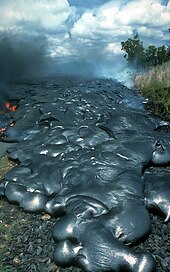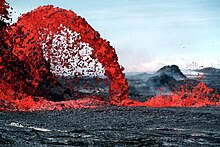Pāhoehoe-Lava
aus Wikipedia, der freien Enzyklopädie

Pāhoehoe-Lava (hawaiisch pāhoehoe)[1] ist die Bezeichnung für eine dünnflüssige (also gering viskose) basaltische Lava mit hoher Temperatur und Fließgeschwindigkeit sowie geringem Kieselsäuregehalt, die nach der Erstarrung eine relativ glatte Oberfläche aufweist.[2][3] Der Begriff wurde von Clarence Dutton in die geologische Fachsprache eingeführt[4] und ursprünglich nur für die erstarrte Lava verwendet.[5] In jüngeren Quellen werden auch fließende Lavaströme als Pāhoehoe(-Lava) bezeichnet.[6]
Beschreibung
[Bearbeiten | Quelltext bearbeiten]
Die sehr heiße Lava strömt unter einer horizontalen erstarrenden Kruste dahin, die häufig in einzelne Schollen zerbricht, sich in Lavarücken aufwirft oder auseinanderrutscht und Lavakissen hinterlässt. Während die Lavaströme noch aktiv sind, kann die bereits erstarrte Lavadecke bis zu 50 cm dick werden. Dadurch können sich Lavaröhren bilden.
Die Oberfläche ist, im Gegensatz zur zähflüssigen ʻAʻā-Lava, ziemlich glatt, so dass sie nach dem Erkalten gut betreten werden kann.
Namenskunde
[Bearbeiten | Quelltext bearbeiten]
Alternative Bezeichnungen sind Fladenlava, Schollenlava, Wulstlava, Gekröselava, Seillava oder Stricklava. Der Name „Stricklava“ hat seinen Ursprung in der äußeren Form der Lava, deren Oberfläche wie ein Strickmuster strukturiert ist. Dieses entsteht dadurch, dass beim langsamen Abfließen der Lava an ihrer Oberfläche eine Art Haut entsteht, unter der die dünnflüssige Lava weiter abfließt und die Haut verschiebt.
Literatur
[Bearbeiten | Quelltext bearbeiten]- Clarence Edward Dutton: Hawaiian volcanoes. In: U.S. Geological Survey annual report of the director, Vol. 4, 1882/83, Washington 1884, S. 81–219. WorldCat
Einzelnachweise
[Bearbeiten | Quelltext bearbeiten]- ↑ pāhoehoe. In: Hawaiian Dictionaries.
- ↑ Ulrich Knittel: Infoblatt Vulkanite, Leipzig: Klett, 2005 (Bearbeitungsdatum: 12. Juni 2012)
- ↑ Pahoehoe-Lava im Lexikon der Geowissenschaften, Heidelberg: Akademischer Verlag, 2000
- ↑ James Furman Kemp: A handbook of rocks for use without the microscope : with a glossary of the names of rocks and other lithological terms. New York: D. Van Nostrand, 1929, S. 258: C. E. Dutton, 4th Annual Report U.S. Geological Survey, 1883, S. 95; Bulletin of the Geological Society of America, Volume 25 / Geological Society of America. 1914, S. 639
- ↑ James Furman Kemp: A handbook of rocks, for use without the microscope, New York: D. Van Nostrand company, 1929, S. 258
- ↑ vgl. Global Volcanism Program 1991. Report on Kilauea (United States), In: McClelland, L (ed.), Bulletin of the Global Volcanism Network, 16:11. doi:10.5479/si.GVP.BGVN199111-332010. Smithsonian Institution: On 18 November, tubes covered the immediate vent area, pahoehoe flowed in the channel to 610 m, then sluggish aa to 550 m.
Text is available under the CC BY-SA 4.0 license; additional terms may apply.
Images, videos and audio are available under their respective licenses.
